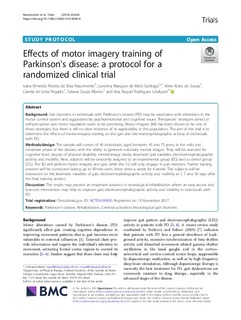| dc.contributor.author | Nascimento, I.A.P.d.S. | |
| dc.contributor.author | Santiago, L.M.d.M. | |
| dc.contributor.author | de Souza, A.A. | |
| dc.contributor.author | Pegado, C.d.L. | |
| dc.contributor.author | Ribeiro, Tatiana Souza | |
| dc.contributor.author | Lindquist, Ana Raquel Rodrigues | |
| dc.date.accessioned | 2020-01-09T09:57:05Z | |
| dc.date.available | 2020-01-09T09:57:05Z | |
| dc.date.issued | 2019 | |
| dc.identifier.citation | Nascimento, I.A.P.d.S., Santiago, L.M.d.M., Souza, A.A. et al. (2019) Effects of motor imagery training of Parkinson's disease: a protocol for a randomized clinical trial. Trials 20, 626. | nb_NO |
| dc.identifier.uri | http://hdl.handle.net/11250/2635471 | |
| dc.description.abstract | Background
Gait disorders in individuals with Parkinson’s disease (PD) may be associated with alterations in the motor control system and aggravated by psychoemotional and cognitive issues. Therapeutic strategies aimed at self-perception and motor regulation seem to be promising. Motor imagery (MI) has been shown to be one of these strategies, but there is still no clear evidence of its applicability in this population. The aim of this trial is to determine the effects of motor-imagery training on the gait and electroencephalographic activity of individuals with PD.
Methods/design
The sample will consist of 40 individuals, aged between 45 and 75 years, in the mild and moderate phase of the disease, with the ability to generate voluntary mental images. They will be assessed for cognitive level, degree of physical disability, mental-image clarity, kinematic gait variables, electroencephalographic activity and mobility. Next, subjects will be randomly assigned to an experimental group (EG) and a control group (CG). The EG will perform motor imagery and gait, while the CG will only engage in gait exercises. Twelve training sessions will be conducted lasting up to 90 min each, three times a week, for 4 weeks. The subjects will be reassessed on the kinematic variables of gait, electroencephalographic activity and mobility at 1, 7 and 30 days after the final training session.
Discussion
The results may provide an important advance in neurological rehabilitation where an easy-access and low-cost intervention may help to improve gait, electroencephalographic activity and mobility in individuals with PD. | nb_NO |
| dc.publisher | Trials | nb_NO |
| dc.rights | Navngivelse 4.0 Internasjonal | * |
| dc.rights.uri | http://creativecommons.org/licenses/by/4.0/deed.no | * |
| dc.subject | Parkinson’s disease | nb_NO |
| dc.subject | rehabilitation | nb_NO |
| dc.subject | cerebral activation | nb_NO |
| dc.subject | neurological gait disorders | nb_NO |
| dc.subject | nevrologiske lidelser | nb_NO |
| dc.title | Effects of motor imagery training of Parkinson's disease: a protocol for a randomized clinical trial | nb_NO |
| dc.type | Journal article | nb_NO |
| dc.source.volume | 20 | nb_NO |
| dc.source.journal | Trials | nb_NO |
| dc.source.issue | 626 | nb_NO |
| dc.identifier.doi | https://doi.org/10.1186/s13063-019-3694-8 | |

